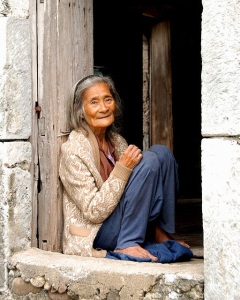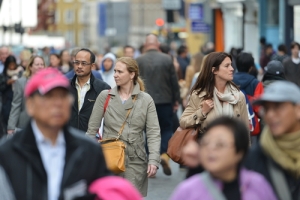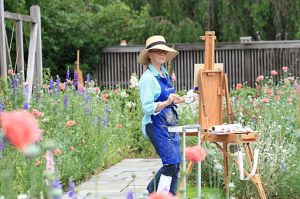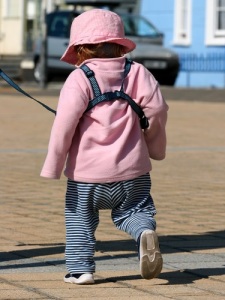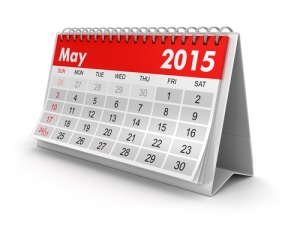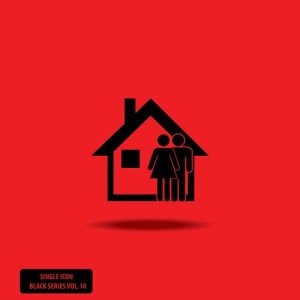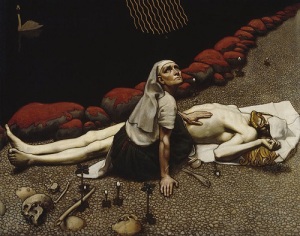It’s a shaming fact that I don’t have a single photo of my mother and me together since she was, ooh, about 69, which would make me in my forties then. Shame on me. But perhaps that’s an illustration – or a non-illustration, no pun intended – of the theme of this blog. Are we ‘close’? I think so, but perhaps one main definition of that term, closeness, for me and her, is that we have so much in common these days, rather than that we’re always in each other’s pockets.
Anyhoo, I haven’t been ultra-personal for quite some while, so I thought it could be interesting to transcribe a conversation she and I had a little while back about our different perceptions of singledom: she at 83, me now 60. I recorded it, with her permission, so here goes.
Paula: My name’s Paula, and I’m 60, and I’m sitting here with my mother Jean in her house in a small market town in Warwickshire, England. We thought it might be interesting to explore what singledom meant to both of us. Introduce yourself, pray do, Mamma.
Jean: I’m Jean, and I was 83 last birthday, 16 September 2014.
Paula: Now you and my father divorced some time ago, and he’s very much still with us, but you don’t see him, although I do. How long is it ago now?
Jean: Over thirty years.
Paula: And you have four children of course. I have two brothers and a sister, and I’m the eldest, but I’m the only sibling, the only child of yours, who isn’t married or partnered with family, with children.
Paula: What does singledom mean to you? Do you regard yourself as single in the same way that I mean single when I talk about me?
Jean: No, not at all. I regard myself as living on my own, which is quite different.
Paula: Whereas despite a few relationships, sadly I just never found the right person to be with, not in the long term.
Jean: [Muses] But I think being on your own has many advantages. Even though it might seem a little selfish, if you like to call it that, you can do what you want, when you want to do it.
Paula: Yeah, I quite agree with you on that. You can have your own routines, your own habits, you can decide where you want to travel to, where you want to go on holiday, when you want to go, even things like who does the washing up, when you get up in the morning….
Jean: Yes, that’s right.
Paula: Well it’s true, isn’t it? In a sense you can spoil yourself in that way.
Paula: But I think you’ve said to me that you’d hate to be seen as selfish as a person.
Jean: Yes, I’d hate to be labelled selfish. And so I do try to help other people whenever I can.
Paula: Yes, absolutely. [Pondering] And I also think that as I’ve got older I’ve got more keen on socialising with people who, like me, are single, or see themselves as single. Because I don’t feel I have so much in common with friends who are in a couple, or, even, who have children, because I don’t have children either, as you know. And of course in that we’re different, because you have children, including me, and also seven grandchildren. So I do find that I seek out the company of my single friends. I do still see my friends who are in couples. But what about you? Do you find you socialise more with single people?
Jean: Well maybe I do gravitate more towards people who are on their own: widowed friends, or friends who are divorced, maybe. And probably people of my own generation, more. But I do remember that as a child, I never minded being alone, because I was an only child. At first it did bother me though, when I was left alone at first….
Paula: You mean when Father left you?
Jean: Yes, yes. But you get used to it. Although you do worry at first about inviting people into your home because you’re on your own, or going to someone else’s house. Because you might get paired up, say, with a single man.
[Paula laughs]
Jean: Or you can feel very out of it if you go out.
Paula: Yes, or you can feel, ooh, they’re just inviting me out of pity, or to make up the numbers, and I think I’ve experienced that as much as you. But in my case, maybe more than yours, I’ve felt that some friends are quite uncomfortable with it, and so perhaps they don’t invite me. And so I think, OK, well all right then, so I’ll see my single friends, and we can have our own conversations. After all, I don’t necessarily want to have conversations I’m not a part of, like children’s schooling, or how your partner’s getting on at work, so we’ll have our own singles’ conversations instead…. But it’s interesting, because it wasn’t until I started talking to you about all this that I realised that I only regard my friends as ‘single’ if, like me, they’ve never found anyone permanent. I’ve also got friends on their own who are divorced or separated, and who I see quite a lot, but for some reason, I don’t regard them as ‘single’ in quite the same way. Which is a weird distinction to make. And that’s especially true if they are divorced or separated but have children. I suppose I regard them as having their own social, i.e. family, unit, so for me they’re not single in the same way. Is it the same for you?
Jean: Yes, though of course I have children and grandchildren, so I can share that with friends in a similar position who are on their own….
Jean: But another thing I’d like to say is that when I was very young, I never minded being an only child. But as I’ve got older and older, I do feel myself very bereft from not having brothers and sisters. You’re so lucky in that way.
Paula: Now that’s interesting.
Jean: You see, you’re so lucky having brothers and a sister, which I don’t have.
Paula: I can see that. I am so lucky in that way.
Jean: Of course, I do have children and grandchildren to support me, which is wonderful. But it’s not quite the same as having close family of your own generation.
Paula: Yes, I do see that now. But I wonder, though. Is it possible that in some way, being an only child was quite good practice for being on your own when you and Father divorced? Was it, in a way, quite a valuable rehearsal, do you think?
Jean: I’ve never thought of it that way till now, but maybe, at least subconsciously, it was.
Paula: You see, for me, I’ve often thought that it might be quite nice to be an only child. You’d be the undivided focus of your parents’ attention, you could be spoilt and doted on.
Jean: I don’t think I was ever spoilt in that way, no, that’s not how I remember it. But I suppose an only child does get all the benefits and resources that are going.
Paula: One thing I’ve always felt about you, maybe because you were an only child or not, I don’t know, is that I think you’re a very good ‘joiner-in’ of things, better than me.
Jean: Yes, I do think I like joining in things, doing things. I think I’m more of a ‘people person’ than you are! I’ve always said that it’s people who really interest me. I’m not nearly so interested in objects, in things. I’m interested in how people cope, in how they tick. I like joining groups and finding out about people. I’m not a stay-at-home.
Paula: No, very true. You see, I think I’m much more of an introvert than you. I like staying at home, I like my own company, and I don’t think I’m as confident at joining things and going to things as you are. And I think that one of my ways through my singledom is by writing and thinking about the world, people and myself, including my single state. The blog I write, for instance, and my novel. I do enjoy people, and I do enjoy conversations, but I think that these days I prefer 1:1 conversations, or conversations with just a few people at a time. I do enjoy people, but I think I’m even happier observing them than interacting with them. I suppose I’m more philosophical about it all rather than practical! Do you think that’s true?
Jean: Yes, I do.
Paula: I think I should engage more, though. At the age of 60, I am trying to join more things, to get more involved with stuff that interests me. I think I should at my age.
Jean: It’s not that I mind being on my own. I still enjoy my own company, and as I get older, I think I get better at being on my own. I find I can focus on one thing, and…
Paula: Well that’s certainly true. You can certainly get more done! I find I can get more done! And I don’t know about you, but I’m not very good at multi-tasking, I’d rather concentrate on something and get it finished.
Jean: And I do like my routines. I’m not good if my routines get thrown out in some way.
Paula: Well that’s certainly true of you! I thought I was bad enough, but you’ve certainly got a severe case of routine-itis….I would say, though, that at times I do miss someone special in my life…. Until, I have to say, I think of one of the main advantages of my own singledom as I get older, and that’s not being one half of a couple and having to go through the pain and loss of witnessing someone disappearing into old age, illness or death. I do count my blessings on that.
Jean: Yes, absolutely. I have to say, when I see my friends in couples losing each other, it’s a loss far more devastating, as far as I can tell, than it would be if they were much younger. They’ve been through so much together. I agree with you, that’s such a blessing for both of us.
Paula: If I’d had a long-term partnership now, that I’d fully entered into, I know I’d have been absolutely crippled by the death or loss of the other person. I don’t know that I’d have coped, quite frankly….
Paula:[Muses] One thing I’d like to say to you genuinely, and I know this is being recorded then transcribed, but still, is that I’m so full of admiration of the life you’ve made for yourself as a single person. I mean, you’ve done masses of things that I don’t think you would have remotely considered or got round to doing if you were still with Father. I mean, you’ve got a degree now, you’ve joined so many things, you did an Advanced Driving Course, you manage all your finances, which you wouldn’t have done if you’d stayed with Father, in your traditional married-woman role, you’ve travelled all round the world on your own, sometimes to some very adventurous, exotic places, you’ve taken up all sorts of hobbies you might not have done otherwise…. I think that’s what has brought us so much closer together: that independent-spirited nature which a single person has, probably has to have, to survive and thrive.
Jean: Of course, when I was younger we, particularly women, never had all these opportunities anyway. Not to go to University, or travel abroad. But my elderly cousin said, ‘Get yourself abroad, Jean!’ – so I went! The first time I’d ever travelled alone. I went to New Zealand, the States and Canada, Hawaii, Fiji, Tahiti, Bangkok, Singapore, Hong Kong….
Paula: And now we have that in common too – a shared passion for travelling, as well as for music, art and architecture. I love travelling alone, as you know: you so often see more, experience more, get to talk to more people. And now, because we get on so well, we travel together quite regularly. We’ve been on holiday to Portugal, Bruges, Madeira, Prague, Australia, Sri Lanka, California – and this year we hope to spend Christmas together in Salzburg, don’t we! Singledom is wonderful if done right alone, but it’s also fantastic experienced right together, isn’t it?
Jean: [Laughs]
Blog readers, if you would like to join the 83-year-old ‘Single Jean Fan Club’, please form an orderly queue.
I’ve been scribbling here for over two years now. In that time I’ve found so many astonishing, inspirational, quirky, helpful and informative blogs and websites. I’ve quoted loads. Now it feels like time to take stock: to give you my pick of some of the best.
GENDER BLURRING
Living doll networks (female masking): http://www.maskon.com/kerry/links.htm
Cross-dressing articles from the Gender Centre, Australia: http://www.gendercentre.org.au/resources/polare-archive/archived-articles/cross-dressing-magic.htm
Gender-neutral language: http://genderneutralpronoun.wordpress.com
Transgender forum for all who are or feel this way: http://www.tgforum.com/wordpress/
Fuck Yeah Andrej Pejic: a website that celebrates the beauty of this astounding model and ‘redefines androgyny’: http://fyeahandrejpejic.tumblr.com/
Stunning photography by Jill Peters of the ‘sworn virgins’ of Albania who dress and live male to exist more fully in a male-dominated culture: http://www.jillpetersphotography.com
AGEING, ANTI-AGEISM
This Chair Rocks. Evangelises powerfully against ageism. Started by the admirable Ashton Applewhite, recently lauded as one of the world’s most inspirational women: http://www.thischairrocks.com/
Ageing Without Children, a UK site. Militates for change in health and social care policy for the older and childless, given the growing demographic in this respect: http://awoc.org/
The Red Hat Society, a global sisterhood of women who communicate or meet, wearing red hats and purple clothes (as in the Jenny Joseph poem ‘When I grow old’), to celebrate womanhood at all stages of life: http://redhatsociety.com/
A Child After 40. Supportive and informative US site looking at the realities of being, or trying to be, an older mother: http://achildafter40.com/
Similar for the UK, Older Mum: http://oldermum.co.uk/
The Old Women’s Project. Focused on ageist language and attitudes to women: http://www.oldwomensproject.org/
Women, body and society. Cross-cultural differences in menopause experiences by Gabriella Berger and Eberhard Wenzel: http://ldb.org/menopaus.htm
Site full of inspiring and endearing portraits of older people with positive attitudes: http://betterlife.jrf.org.uk
CHILDLESSNESS
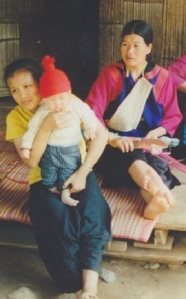
Thailand: a weaving woman looking at a woman with a child, taken by Peter van der Sluijs, Wikimedia Commons
Gateway Women, friendly and compassionate site for women unable to have children through choice or circumstance, or struggling with that possible future. Also has local Meetups. Small annual subscription. http://gateway-women.com/
TheNotMom, similar non-sub site in the US. Also has annual conferences. http://thenotmom.com/
Life Without Baby, another friendly US chat forum, non-sub, with articles and blogs. http://lifewithoutbaby.com/
Childless Mothers Connect. Similar US site, non-sub, but also active in getting women involved in ‘adopting’ children via long-distance connections. http://www.cmoma.org/cmc/
Savvy Auntie, for all women – aunts, godmothers, adoptive aunts – ‘who love kids’. Founder coined the term PANKS (Professional Aunts No Kids).http://savvyauntie.com/defaulthome.aspx
The Pursuit of Motherhood, a blog by Jessica Hepburn, still pursuing her dream of children despite heart-breaking setbacks. https://thepursuitofmotherhood.wordpress.com/
Another one for non-parents, UK-based and non-sub. http://www.nonparents.com/
SINGLEDOM AND SINGLISM
Dr Bella de Paulo’s fab site on singlism (her word) in society. http://belladepaulo.com/
The Modern Spinster, thoughtful blog on being single in contemporary society. https://themodernspinster.wordpress.com/
Kate Bolick, writer, puts out this savvy blog on ‘modern spinsterhood’. http://www.katebolick.com/
The Spinsterlicious Life by Eleanore Wells, another good one. http://eleanorewells.com/category/the-spinsterlicious-life/
FEMALE SELF-HEALING AND -DEVELOPMENT
Brene Brown, pioneering speaker, blogger and leader on human/female problems such as overcoming shame and fear.http://brenebrown.com/
Treesisters, ‘an audacious experiment fuelled by the love and creativity of everyday women’ to bring about ‘swift reforestation’ of the globe. Members see this as a metaphor of growth for the sisterhood. http://treesisters.org/
Red Hearth House, a woodland red tent centre in Stroud, Gloucestershire, England with a website, bringing women and girls together through their experiences of the womb, menstruation, the lunar cycle and physiological/emotional womanhood in general: http://www.hearthart.co.uk/
Annabel Du Boulay, women’s therapist/healer working out of Glastonbury, England, especially on ‘womb wounding’: any kind of distress related to womanhood and/or child loss or hurt: http://www.belashka.com/
WOMEN’S COMMUNITIES
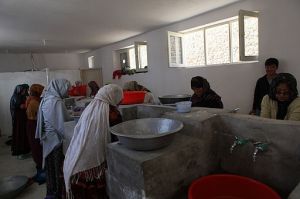
Bamyan Women’s Community Centre, Afghanistan, taken by Sgt Heidi Agostini, copyright Wikimedia Commons
The first (mixed gender) self-built cohousing project in the UK. Lived there myself for a while. http://www.therightplace.net/coco/public/
Online list of all-female communities worldwide: http://metro.co.uk/2013/03/05/where-women-rule-the-world-matriarchal-communities-from-albania-to-china-3525234/
Alapine Community, an ‘all-womyn’s intentional community’ in the US: http://www.owch.org.uk/. http://www.alapine.org/herstory.html
ART AROUND ALL OR ANY OF THESE THEMES
Suzanne Heintz. Wonderfully tongue-in-cheek photography/installations about female singlehood (lack of a ‘family life’) and childlessness: ironic take on Motherhood and Apple Pie. http://suzanneheintz.com/
Painter Sam. Samantha Bennett, who paints butterflies into her portraits to represent her subjects’ loss of an infant and the hopes of transformation from that experience: http://www.paintersam.com/
Bloom, literary site devoted to highlighting, celebrating, featuring and reviewing older writers: http://bloom-site.com/
The Walking Art Project in Cumbria, England, devised by Louise Ann Wilson. An ‘interactive artwork’ in the upper Cumbrian fells. Women who are childless are guided through the landscape, helped to identify positive landmarks of their state from the beautiful details of their natural surroundings. https://louiseannwilson.com
Interesting androgyne art: Alan Feltus, http://www.alanfeltus.com/; John Stezaker, http://www.saatchigallery.com/artists/john_stezaker.htm; and Claude Cahun, http://courses.washington.edu/femart/final_project/wordpress/claude-cahun/
The agony and ecstasy of losing and lacking children: Frida Kahlo. http://www.fridakahlo.com/selected-artwork
By Ana Maria Lassnig, the brutal but amazing and life-affirming Du oder ich, eighth self-portrait of the artist ageing, illustrated at http://www.hauserwirth.com/exhibitions/25/maria-lassnig/view/
Benita Stoney. Illuminating, positive images of older/ageing (and younger) subjects. https://benita-stoney.squarespace.com/gallery
And now, enjoy…

There was an old woman who lived in a shoe./She had so many children she/we… didn’t know what to do???
OK, so I’m 60, never had children (never found the right mate), even tried to adopt for three years and that failed; always been sad about that – though these days I assuage my mothering longings in other ways. (I’ve written about childlessness many times on this blog, as my BoyWoman regulars will know.) But now I’m thinking: could I still be a mother, even at my age? I mean, to a naturally born baby of my own? How would I feel about that: morally, physically, emotionally? Could I cope: not just with the demands, but with my own conscience, and with societal attitudes in reply?
The prompt that got me quizzing myself was the recent news (23 May 2015) of a 65-year-old German teacher, Annegret Raunigk, already mother to 13 children, who’s now given birth by Caesarean to quadruplets. (By my tally that makes it 17.)
Annegret isn’t unique. In 2008, following IVF treatment two 70-year-old women in India gave birth. (Apparently on that continent, childbearing at 50 is not so uncommon.) Worldwide, 2008 saw about 8,000 childbirths to women of 45+, 541 of these to the over-50s. In 2012 154 babies were born to British mothers over 50 (and the UK has the highest age threshold for women entering on motherhood in the first place: average age 30). Globally, the number of births to women at 40+ has gone up 13% from 26,419 in 2008 to 29,994 in 2012, meaning that today, 1 in 25 babies are born to mothers who are beyond 40. (There are even websites now, Older Mum: http://oldermum.co.uk and A Child After 40: http://achildafter40.com.) In the US a number of grandmothers have produced offspring for their daughters. Of course, I’m not a grandmother either; but how must these women feel? And how should society respond?
My knee-jerk is to condemn: selfish, population explosion, straining world’s resources, mutter mutter mumble…. But I think I’ll dig more deeply among the research and my brain cells, weigh up the pros and cons. These women are my sisters, after all.
One constellation of reasons why not to try this at home? According to traditional statistical sources, woman’s fertility begins to decline after age 27: after 40, she has about a 5% chance of getting pregnant each month. This means that the ‘miracle’ stories of late motherhood are often IVF stories, or at least, tales of some kind of ART (Assistive Reproductive Technology), whether those women – some of them celebrities – choose to say so or not (Would I want to undergo the trials and tribulations of ART, and all that expense?, I wonder to myself….) The news media lap these up – never, of course, dwelling on the high proportion of failures and maternal journeys to despair. And whatever the means of impregnation, the risks of dangerous complications shoot up as a woman gets older: gestational diabetes; high blood pressure during pregnancy; premature birth; low baby birth weight; multiple pregnancies; miscarriage; ectopic pregnancy; a child with chromosomal abnormalities, e.g. Downs, etcetera etcetera. Then, of course, there’s the (arguably outdated) medical profession’s attitude to older expectant mums: anyone over 40, would you believe, is classified as of ‘advanced maternal age’, ‘elderly primigravidas’, a 1950s term, and at ‘high risk’. Hmmm.
But are there any counter-arguments, facts and figures? A 2013 article by psychology researcher Jean Twenge of San Diego State University in Atlantic Monthly, quoted in A Child After 40, states that there are: that the general wisdom above is often based on French birth records dating from 1670-1830, an era before that of reproductive science, antibiotics and advanced nutrition. The Real Challenges and Benefits of Having a Baby After 40 (http://achildafter40.com/challenges-benefits-baby-after-40/) also cites, via Twenge, ‘some rarely mentioned modern research’ which concludes, apparently, that women aged 35-39 have an 82% chance of conceiving within a year if they have sex twice a week, and other findings that – before the era of contraception, at least – 89% of 38-year-old women were still fertile. Further studies quoted on the same website seemingly show that since most women of 50+ use donor eggs, the risks of chromosomal abnormalities are low; and (2012, University of Columbia Medical School) that 50-year-old pregnant women fare just as well as those aged 42. Their researches also discovered that women over 50 had similar rates of complications, such as gestational diabetes and premature labour, as women under 42 who’d had eggs donated; and although older women had slightly higher blood pressure rates, the difference was small, and might and have been due to chance. So who and what to believe?
Back to the negatives. In 2012, geneticists in Iceland found that fathers pass on more genetic mutations to their children as they age, some resulting in schizophrenia and autism, with 40-year-old men twice as likely to father a schizophrenic child. Dr Avi Reichenberg, a psychiatrist at King’s College London, has also been looking into how genes are affected by factors other than the underlying DNA (a study known as epigenetics). How people eat, drink, smoke, are exposed to pollution, pesticides and other endocrine disrupters and get stressed may cause sperm cells to mutate, with consequences for the resulting offspring; and it’s obvious that, the older you are as a parent, the more time you will have had to be genetically affected by your lifestyle and surroundings. Reichenberg goes on to confirm the Icelandic guys’ findings that ‘the proportion of children of older fathers or mothers who have psychiatric or neurological disorders is higher than in children of parents of average age.’ (http://www.telegraph.co.uk/news/health/news/9928198/Are-older-parents-putting-our-future-at-risk.html) This trend, plus the other higher physiological risks that are recognised for newborns to late mothers, inevitably put more strains than are felt from younger mothers on our health and care services. Oh dear.
Upsides again? Reichenberg reminds us that The risk has always been there. It’s only now that we are starting to understand it.’ So this is nothing new. And there’s more along the ‘nothing new’ line. Turns out that in fact, for the first half of the 20th century the number of births to mothers of 40+ was much the same as it is now – in fact, there was a great surge in late motherhoods after World War II, when couples were reunited (with more babies born to women over 40 in 1947 than in 2011!). It’s only that feminism, and all the female opportunities that that and better birth control brought, plus an increase in separations and divorces, have brought these figures down since – not any underlying truth that older women aren’t able to procreate; and only contraception, and smaller families, that made society start to feel that conception after 35 seemed unnatural.
Further ‘Bah! Humbug’ thoughts against the whole idea of later motherhood: Talking of feminism, at age 60 would I really want, suddenly, to have to change my routines; abandon or curtail some of my hobbies and passions; maybe give up my job, or go part-time? de Beauvoir, Friedan, Greer et al. paved the way and fought hard for what I’ve got now – and I appreciate it hugely.
But what of the positives for offspring of these births? After all, shouldn’t we be more concerned about the children than ourselves as potential parents, here, in the first place? According to research, the children of IVF in older mothers performed better on a whole range of intelligence tests. (https://www.psychologytoday.com/blog/singletons/201110/50-is-the-new-40-having-babies) And other work, too, has shown that ‘three-year-old children of older mothers are likely to have better language development and to experience fewer unintentional injuries…. Positive and responsive parenting generally increased with maternal age up to about age 40.’ (Jacqueline Barnes, Julian Gardiner, Alastair Sutcliffe, and Edward Melhuish, The parenting of preschool children by older mothers in the United Kingdom, in European Journal of Developmental Psychology, 2013, publ. Taylor and Francis). Clinical psychologist Oliver James agrees: ‘There is evidence that older parents are better parents: they related well to their babies and toddlers, they provide better discipline, and the outcomes are better.’
More reasons why not? Given that older women, these days, are having babies around 40-50, I wonder how many have thought through that their peak years of rearing are likely to take place around the time of their perimenopause/menopause – as ‘The Real Challenges and Benefits of Having a Baby After 40’, A Child After 40.com, puts it: when ‘the King Kong of postpartum will meet the Godzilla of perimenopause’, creating ‘a potentially explosive impact between estrogen, progesterone and stress hormones, not-to-mention emotional highs and lows’. As I remember from my own menopause, that can be a heckofalot to cope with. But there are two-edged arguments here. Some insist that, however lively we feel these days into our 40s, 50s, 60s and beyond, childcare will sap those levels of energy. But…
On the pro side: Annegret Raunigk, she of the 17 children, says ‘[They] keep me young.’ She seems to believe that a positive attitude will help her physical and emotional wellbeing: ‘I’m not actually afraid. I simply assume I’ll remain healthy and fit.’ Lisa Miller, writer of Parents of a Certain Age in New York Magazine, interviewed 60 and 66-year-olds Maloney and Ross whose children are 7 and 10: ‘”You don’t know how high-energy, actually, both of us are,” Ross claimed (http://nymag.com/news/features/mothers-over-50-2011-10/). And sure enough, some studies have found that 50-somethings mothers reported less parental stress and the same levels of fatigue as 30- and 40-year-olds (Psychology Today, above).
Any more why nots? Yep, heaps. Women who start popping babies late tend to have smaller families, whether they like it or not – especially those using ART, donor eggs or surrogacy for a first child, since this can drain the resources to finance subsequent children. Is it good for more children to be an only child? Some may say yes, some may say no. And as the Daily Telegraph article puts it, with this and an ageing demographic generally in many countries, ‘society is becoming increasingly top-heavy, with a dwindling supply of young people around to work, pay taxes and do the heavy lifting’. But there’s more to it than that. Having a child at 55 or older brings a higher chance that you won’t live to see them into adulthood. It also becomes less likely that they’ll ever know and love their grandparents, or others close to you of the generation above. You may find yourself involved in providing elder and toddler care simultaneously. Maybe more worrying still, who will care for you if you can no longer care for yourself? With the cracks widening in the current social and health care systems of many countries, there may be far fewer places we can turn for aid in a future not so distant: the cert is dwindling that your own offspring will want or be able to do this particular kind of ‘heavy lifting’.
And yet… In 2010, over 3 million grandparents in the US were responsible for raising their grandchildren, and few have questioned their fitness to do that! Moreover, women over 40 are more likely to have pursued higher education, achieved personal growth and are now ready, fully, to dedicate themselves to parenthood; there’s also more chance that they’ll have attained management/executive roles, won themselves significant salaries and built up more savings and resources – so perhaps they can afford more care and more ART after all?? It seems that in late mothering, as in much, our society and female existences are full of contradictions.
So what about the notion that older women are selfish to want children, especially multiple mothers like Raunigk? Don’t they sap our planetary resources, which are anyway shrinking, or contribute to a population explosion? Well, despite the increase in births among the over-40s, actually birthrates among women overall had – at least, in 2011 – declined 4%. Hang on. I’m getting v. confused.
More objections to late parenthood: It’s no fun to experience the ageism at the school gate, at parents’ evenings or in other gatherings; or to be assumed to be a grandma, not a mother to your child. Could I, or many, take such current everyday biases?
I’m still bemused. And here some final, even more bemusing thoughts. In May 2015, the scientific and popular press reported that, thanks to experiments in mice, we might soon be able to turn off one of the female body’s genetic switches, delaying (indefinitely?) the onset of the menopause, and thus prolonging the production of our own healthy eggs (http://www.independent.co.uk/news/menopause-may-soon-be-postponed-1068161.html). Other experiments are looking at re-inserting tissue from our ovaries later in our lives, thus keeping the ovarian tissue pumping oestrogen, postponing perimenopause. Diets, too, such as the ‘paleo diet’, are being tried.
In 2014, overall human life expectancy around the world hit an all-time record of 71.5 years, and human beings are healthier than ever before. Whether we like it or not, choose to be a ‘late’ parent or not, science is changing the goalposts around us.
If we can afford the science, maybe we just have to accept that we’re going to fund some vast physiological adjustments; and if we do that, maybe we’ll have to militate to fund corresponding changes in societal attitudes, familial living arrangements, health and social care systems, too, to match.
Do I now want to consider being a mother at 60? Yuk. Somehow, despite all the above, for myself, it seems unnatural, self-centred and, for me, too late. Here and now, with the failing health and social care systems that we have, I still can’t relish the idea.
Earlier this month, the press reproduced a shocking image: a CAT scan of a suitcase stopped at the border of a Spanish territory in North Africa, revealing a very distressed 8-year-old boy curled up in an agonising foetal position: his parents were trying to smuggle him across.
It got me thinking about the lengths (or should that be limits?) that parents go to to try to secure the long-term wellbeing of their offspring: about the irony of mothers and fathers buying the many parental accoutrements of constriction currently in use – buying them at a not insignificant financial and sometimes emotional and ethical cost – yet aiming them at their children’s ultimate freedom and good.
Cards on the table: I’m not a parent. But I’m a multiple aunt and godmother, and have worked with children and young people and their parents for much of my life; so I’m still allowed to observe, I hope, on parenting and its challenges.
The story of the child harness, or child reins, is an interesting one. ‘Leading strings’ may date back to the 17th century Netherlands as devices of tied rope used more to help teach children to walk than as restraints. Rubens and other painters feature them in their art through to the 19th century; but it was urban growth from late that century and the increasing dangers from motorised traffic into the 20th that prompted their more widespread use, especially in towns, to keep children close at hand and safe. (I’m 60, my sister and brother in their 50s: we were trotted around on child reins when we were small.) And yet harnesses then fell out of fashion – only to come back somewhat into common use more recently. But why? According to social historians, it was 1993 and the horror of the Jamie Bulger case that caused another pendulum swing. (Jamie was the toddler abducted by two older children from a shopping centre where he’d been taken by his mother, and brutally murdered on a railway line in Liverpool.)
The harness’s changing patterns of use is what really makes this historical cameo fascinating. As child-rearing historians and experts point out, ‘The history of child-rearing practices [is] characterized by radical vacillations between a positive and nurturing concept and a negative and suppressive perspective’ (History of Child-Rearing Practices: http://www.lotsofessays.com/viewpaper/1687138.html).
‘In antiquity, adults regarded children as troublesome animals; and until two centuries ago, children were treated much like pets and were used and abused even unto death…. The nineteenth century saw an idealizing attitude emerge that made raising a child less a process of conquering its will than training it, guiding it into proper paths, and socializing it to become a useful member of the nation…. More recently, the “helping” mode of child rearing began. Here the parent is encouraged to let the child’s physiological and psychological needs as they emerge determine what guidance and assistance is to be given.’ (Child Rearing in the Past, http://the-ultimate-frontier.org/Family%20Home/Child%20Rearing%20in%20the%20Past.htm)
Parents have to be honest with themselves, I guess: to admit that the ups and downs in modishness of all the different types of child restraint they can resort to are a reality not only because of parental desires for the best for their children but also driven by their own concerns and fears – furthermore, the researchers say, very much by their experiences of how they themselves were raised.
Some have studied the influence of parenting experts on all this, too. According to Ann Hulbert, author of the 2003 book Raising America: Experts, Parents, and a Century of Advice About Children, f’rinstance, every single prominent parenting ‘expert’ from the 20th century has a background of either reverence for or reaction against their own parents, subjective experiences which have imbued their iron-clad theories about what is ‘right’ for children, however much they may claim that they’re based on scientific ‘fact’. The same must be true of many lay parents among us.
Of course there are micro-cultures of parenting fashion, too. Until recently I lived in a cohousing community (see my post: https://boywoman.wordpress.com/2014/08/17/can-single-childless-older-women-live-better-in-all-female-communities-asks-pc/). This progressive housing estate encapsulated for me the two ends of the current parenting spectrum. Some parent neighbours, many influenced by the teachings of Rudolf Steiner, let their offspring roam free around the (only partially enclosed) neighbourhood, unchastised if they climbed on shared windowsills, or railings overhanging vertiginous drops (it’s a very steep site); if they jumped from one piece of communal furniture to another; or if they got up and shouted, sang, danced, played and obscured the audience’s view during communal musical and dramatic performances. These parents believe (I hope I represent their views aright) that children should be allowed to discover their own limits, dangers and self-discipline. (In what may seem a contradiction of this stance, some even practice ‘co-sleeping’ with their children until they’re as old as 7 or 8, not wishing to oblige them to have their own bedrooms until they state their own readiness for one.) Other neighbours parent in the more traditional mode, imposing rules and limits and their own ideas about discipline. For those of us childless on the estate, or whose children had grown and migrated elsewhere, watching these child-rearing tugs of war and sometimes feeling we wished to intervene in the public communal spaces was a tense – and not always spectator – sport.
Apart from the child harness, there are masses of other restraining (and/or secure and reassuring, depending on your point of view) devices and methods that can cause much controversy: the baby sling; the baby bouncer; the baby monitor; the child seat; changing physical restraint practices in schools and secure units; parental locks on the computer; the playpen.
Ah yes, the playpen – in the US often called the kiddie enclosure. Many parents still use them, but many equally have qualms. Its origins may be the ‘naughty cage’. This was a piece of Victorian equipment used in some schools to segregate the badly behaved from the rest in large and busy classrooms. I encountered one of these, wooden, with sturdy bars – treasured as an amusing artefact for the foyer, I hasten to add – known as the ‘naughty boys’ cage’ – in a UK primary school where I once worked. Strangely at odds with his progressive work, even Joseph Lancaster, a 19th century educational pioneer, avoided such punishments as beating children in favour of suspending the naughtiest of the naughty in a cage from his classroom ceiling (http://www.historytoday.com/pen-vogler/poor-child%E2%80%99s-friend).
As for the playpen (in places now rebranded the Pack’n’Play® or the playard – play-yard), parents’ arguments pro are: it sets young children helpful boundaries; its reachable balustrades even encourage them to stand and take their first few steps; it can be filled with exciting stimuli (toys, mobiles, playmats, musical instruments); it bars young ‘uns from the harm of plug sockets, stoves, fires, stairs, open windows, pets, other potentially aggressive, jealous children; it allows the parent uninterrupted time to do chores that may also be dangerous or frightening (ironing, cooking, hoovering). Arguments con are: child-proofing your home (plug protectors, stair gates, fire guards) is a better solution, more closely mimicking the open spaces of the real world, but in a safe, navigable way; and that such devices as the playpen are the first compromise to good parenting. According to Penelope Leach’s Your Baby and Child, ‘babies who spend hours confined in cribs or playpens, with few toys and minimal adult attention, are very slow in learning to reach out and get hold of things and that means they are also slow in discovering what can be done with things’. And Mavis Klein’s The Psychodynamic Counseling Primer claims that ‘children of about seven or eight… who were, as infants, regularly confined in playpens, are less competent at reading and writing than those who were not’; and John Rosemond, in New Parent Power!, that ‘children who spend lots of time confined in cribs or playpens suffered delayed speed and are less coordinated’.
I can’t find research studies or data to back up these pronouncements; however, many parents these days express guilt about the possible anaesthetising effects of their regular usage of the modern-day virtual equivalents of the playpen – the TV, computer gadgets and mobiles, and the DVD – in order to soft-touch-immobilise their offspring, keeping them supposedly ‘safe’ from harm.
Coming back to fads and fashions. We’re filling our materialistic world with artefacts, huge numbers of them aimed at ‘securing’ our children for their own good. In many societies, these items quickly become ‘must-haves’: not only to upstage fellow parents but to prove to others that one’s parenting is research-responsive, and sometimes, to legally comply. Health and Safety and parenting advice continually shift however over, e.g., the designs of buggy/pram that are ‘best’ for baby (forward-facing, backward-facing, low, higher up). Re: car seating alone, in UN countries parents must graduate their child through rearward-facing/combination seats (rearward/backward-facing) to forward-facing seats to high-backed seats to booster cushions of changing weights, sizes and specifications.
Unless you’ve been in a playpen yourself with an oversized child’s cycle helmet over your head for the last couple of decades, it can’t have escaped your notice that spending on children’s things generally has skyrocketed. In 2012, first-time UK parents-to-be were spending £100 on toys; the status symbol of the pram/pushchair/buggy now accounts for 30% of all spending on baby/nursery products; in 2011, nearly 20% of parents had bought a TV for their baby’s bedroom. Strikingly, a 2013 survey put UK average spending on toys per child each year since 2009 at around $450, topping even US spending (followed by France, then Germany, then Russia, Italy and Spain)!!!(http://www.statistica.com/statistics/194424/amount-spent-on-toys-per-child-by-country-since-2009/). Such trends are not so much due to peer pressure, parenting guru Frank Furedi argues, as the fact that increasingly parents regard their children, and their treatment of them, as a reflection of who they, the parents, are – not helped by the further fact that governments and political parties frame children’s development more and more as a commentary on parental accomplishment. ‘That kind of [public] pressure erodes the line between mother and father and child, financially and emotionally,’ Furedi says. (http://www.bbc.co.uk/new/magazine-13393192)
A thought-provoking question: what d’you consider the most notable parental boundary for children in this day and age, certainly in more wealthy cultures? My answer: you could say, the physical bounds of the bedroom. Here, maybe, is the new-form cusp of the conflict between children’s impulsions to freedom and any constraints that adults set them. On Saturday 16 May, the UK’s Daily Telegraph Magazine featured six photographers’ images of their children in their rooms (in Brazil, the Netherlands, California, London….) The piece was glossed by such parental comments as ‘They spend a lot of time playing together in here – otherwise they would take over the whole house‘ (my italics); ‘The colour of Ella’s room has changed many times…. I haven’t looked [at it] carefully in a while‘ (again, my italics); ‘Gus redecorates his room several times a year.’
What strikes me (and I know I’m far from the first to remark on this) is an impression of an exponential increase in children’s autonomy but also, potentially, of their isolation within the family household. Further, having computers and TVs in their rooms at once frees children and potentially holds them captive – even though partly in an adult effort to secure them from more harm ‘on the outside’. Meanwhile, once children are inside these private, self-designed spaces, how much do their parents remember to keep in touch with how their little ones are developing: to track and notice what is really going on?
There’s an age-old undercurrent even to these trends that intrigues me. Look at what some would call less developed societies and we’re sharply reminded that even now, multitudes of adults regard children as ‘other’, as not the same as them. The Arunta of central Australia and the Eskimos of the sub-Arctic regard children as the bearers of spirits of ancient Aborigines and Eskimo relatives respectively. Some African communities fear malignant witchcraft or Ndoki, believing it targets children particularly, either in the womb or the early years, often invading its objects through infected food; the result: traumatising child exorcisms, or even child trafficking and ritual child sacrifice.
I can’t help thinking that even in the so-called developed world we have a two-faced attitude to childhood: that young people are simultaneously little projections of ourselves, of our desires, of what we’d like to be, and on the second hand ‘other’, untarnished, unknowable and unknown – and part of us would like them to stay that way.
Expressed in child-friendly language, the UN Convention on the Rights of the Child upholds children’s right to ‘a safe place to live’; ‘a clean and safe environment’; ‘to find out things’; ‘to privacy’; ‘to protection’; ‘to play and rest’. It also states that ‘No one is allowed to punish you in a cruel or harmful way,’ ‘You have the right to find out things,’ and that ‘You have the right to get information that is important to your well-being…. Adults should make sure that the information you are getting is not harmful.’
So what do children think about all this themselves? A 2010 Irish survey of 6 to 17-year-olds discovered that, across this span, although wide, children appreciated that:
‘- Parents represent important figures of authority and control… the monitoring and checking of children’s activities and whereabouts, enforcing limits and boundaries, and disciplining….
– Rules were necessary in order to protect children from harm and to promote their well-being…. Avoidance of risk and safety issues were highlighted in children’s narratives.
– Parental monitoring of children’s behaviour and whereabouts was facilitated largely through talking, asking questions and via mobile phones….
– Older children emphasised the need for their right to privacy to be balanced with parents’ right to monitor and regulate their activities….’
(From Children’s Perspectives on Parenting Styles and Discipline: A Developmental Approach, published in the National Children’s Research Strategy Series: https://www.tcd.ie/childrensresearchcentre/assets/pdf/Publications/Children%27s_perspectives_on_parenting_styles.pdf)
From the above – and again, this isn’t an earth-shattering thought – what seems required far more with children when negotiating the knotty problem of boundaries is cross-generational communication – as found above from children themselves, who valued ‘talking, and asking questions’. But the question remains, what to do when children are as yet too young, or immature, to engage?
Take swaddling. From times of yore newborns were tightly bound so that they had no ability to move at all. Held thus, they could be hung on a peg, laid on a shelf or put in a receptacle of the parent’s choice and convenience. (There were reasons given for this: that babies’ limbs were not yet fully ‘set’, and they might also damage themselves or others by thrashing about.) Rendered almost totally passive, their hearts would slow down, they would sleep more and be more generally withdrawn. After nine months, the infant was kept docile by underfeeding and purging; when of crawling age, as crawling was seen as the demeaning behaviour of animals they were held in restraints or stocks until they were old enough to walk. It was only in the late 1700s and into the 18th century that other ideas about child rearing emerged.
And yet, and yet…. In the late 1960s my much younger brother slept in a kind of zip-up sleeping bag, designed to keep him from throwing off the bedclothes in his cot; and now, today, swaddling is almost popular again, albeit in a looser, more temporarily used and humane form. Parents report that their babies are ‘happy’ sleeping, and sleep more deeply, in so-called swaddle pods, their legs and arms folded far away inside. Certainly, the enthusiasts declare, they can no longer scratch themselves or poke their fingers in their eyes. Without being able to question their infants, or include them as part of some longitudinal study into childhood development, the doubt of course remains: how will we ever know what is ‘good’ for these swaddled ones for sure?
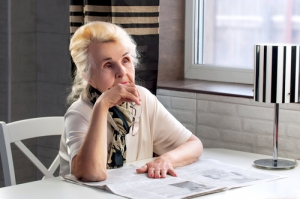
Our texts are steeped in age-based prejudice and cliché. Image copyright Roman Globa, courtesy of Shutterstock.
A few weeks ago my mother got a copy in the mail of a medical specialist’s letter, also sent to her doctor. It read ‘Jean is a sprightly lady of 83…’. My mum chortled, sure she’d received a compliment, delighted with the metaphorical pat on the back; on further reflection, my characterful mater wasn’t so sure about it. Last year, my father was in the throes of a large-scale, no-holds-barred party that he’d organised with his usual panache when he suddenly collapsed with a condition that occasionally recurs but which the paramedics couldn’t rectify on this occasion without taking him to hospital. As I walked beside his gurney to his little treatment room, the doctor asked, ‘Mr X, how young are you?’ ’85 and a half,’ he answered humorously and proudly. Again, he chuckled at what he perceived to be a compliment. But were these, really? I think of other well-meaning phrases that aim to praise or flatter older people: ‘spry’, ‘sharp as a tack’, ‘independent’, ‘still going strong’, ‘perfectly compos mentis’. We’d never use them of someone aged 20, or even 40. So aren’t they actually patronage in thin disguise?
There’s a wonderfully militant website for older women which points out such subtle iniquitous wrinkles in common parlance: The Old Women’s Project at http://www.oldwomensproject.org/. Certainly for older women, condescending phrases such as ‘little old lady’, ‘you lovely ladies’ and even ‘you girls’ trip off the tongues of too many far too often. Truth is, older people are rounded, unique individuals, some frail or needy or ill, many stout and hearty and strong-willed and maybe far from ‘ladylike’, ‘lovely’ or ‘girlish’, and with years of experience ahead of them, let alone decades behind them.
Of course the semantics of age and ageing is a touchy and subjective topic, clouded in confusion by the fact that across cultures and generations, acceptable usage changes. Just as ‘homosexual’ and ‘queer’ were over the years superseded by ‘gay’ (which now seems to default in certain contexts to a preference for ‘queer’ again), so such labels as ‘older people’ are currently ‘in’ while ‘the elderly’, at least in my book, isn’t, being a kind of distancing mechanism, ascribing a kind of otherness to the older ones among us – along with arbitrary groupings such as ‘the over-80s’, ‘the over-90s’ etc, so often alighted on by politicians when contriving their seemingly equally arbitrarily ring-fenced health and social care initiatives (and personally I detest the US predilection for ‘senior citizens’, ‘elders’ and ‘seniors’). Also, the boundaries of the definition ‘older’ keep on shifting: apparently last month Austrian researchers informed us that now, ‘old age’ (whatever that is) doesn’t officially begin until our 74th year.
We all have to navigate speaking in this slippery shorthand of age, and thus often get it wrong: I’m saying ‘all’ not to exonerate myself. ‘Describe her/him: I can’t remember who you mean,’ someone will say, and the reply will probably be along the lines of, ‘S/he’s about mid-50s, tall, short grey hair, smiley’, etc. etc. Invariably the age tag comes first (only trumped by the colour tag – ‘Well, she’s black, 80 or so’, etc. etc.). Now I’m not arguing for political-correctness-gone-mad here – of course we should state the bleedin’ obvious first, e.g. ‘He’s Asian, got one leg’ – but why the laziness of age labels so often first off the bat?
Sorry, media, but journalists and their ilk are the pits at this linguistic sloth and cliché. ‘Rescuers pulled a 101-year-old man alive from the rubble of his home a week after the Nepal earthquake.’…. ‘FRAIL MOBSTER IN FRAME FOR £330M ART HEIST: The FBI is focusing its investigation on an unlikely figure: a wheezing, 79-year-old former mobster…’…. ‘Dave Watson, 55, is … unemployed due to health reasons.’….’MORE EVIDENCE AGAINST ROLF HARRIS: The 85-year-old was handed a six-year jail term last year…’…. ‘Ben E. King, the soul and R&B singer best known for Stand By Me, has died aged 76,’…. ‘The bestselling crime writer Ruth Rendell… has died aged 85.’…. ‘As someone who got married lateish – in my forties -….’….’ Of course [my italics], 64-ish … is when a man starts to feel vulnerable…’.
Surely the media should lead the way in more sophisticated verbal constructions that remind us that age is just a number, not a constraining descriptor or an infallible predictor, not a narrow channel into absurd and unfair generalisations? We ‘aged something-or-others’ or ‘over-whatevers’ are a mixed and uncategorisable bunch, with no desire for shoddy brief journalistic wordage that may serve only to bring to mind those repellent, stereotyping road signs you see near care and residential homes, black silhouettes of hunched, frail figures (‘frail’: there’s another ageist word) toiling along, prodding their weary way with walking sticks.
Commercial interests and advertising steep our textual environment with age-averse messages, which we inevitably soak up. These can be blatant. Witness the brand names: Nivea Cellular Anti-Age skin range; the cosmetic manufacturer Simple’s Age-Resisting Eye and Night Cream; Clarins’ Restorative [my italics] Day Cream (do we all need, and want, to be ‘restored’ – and from what?)…. Marketing blurbs can also brainwash us with more covert and, on the face of it, positive signals: a recliner chair is brought to you by HSL, the ‘comfort [my italics] specialists’ (do all older people want to be comforted, or comfortable?); Specsavers tell us that ‘Life begins at 60 [So does a 25% discount, the ad goes on]’ (implying, then, that some other life ends at 59?); Dogs Trust promises ‘complete peace of mind’ (are we all stressed out? Do we even want peace of mind, to me an anodyne and unadventurous concept?); Clarins enables you to ‘look as young as you feel’ (but that, of course, assumes you want to). Then there are the euphemisms: older people are ‘mature’ and, ‘at y/our time of life’, ‘deserve’ treats, luxury and that dreadful word, ‘support’. Other wordings seem to imply that all older people have limited and housebound horizons: ‘We understand how proud you are of your home’ (Stannah Stairlifts); a residential home will ‘take care of the everyday chores’ (are they chores? And/or, do we all do the ‘chores’ every day, martyrs to our own routines?). Yes, in their contexts some of these phrases may appropriately hit their target audiences; but what I’m saying is that these tropes surely gradually, insidiously, permeate societal consciousness, becoming more and more often used without a moment’s thought.
But wait: our ageist verbiage is not just tinted with prejudice and preconception against the older. I hate the American ‘senior’ and ‘elder’ not so much of themselves, implying, as they do, wisdom and experience, but because they also suggest a counterpart ‘junior’, with its connotations of ‘inferior’. Call me an idealist, but I’m not looking for ageist favouritism at the expense of those who are younger: just a level field.

Younger people suffer from our ageist language too. Image copyright Chaloemphan, courtesy of Shutterstock.
For me, the sphere that crystallises the pervasiveness of the problem is the job market. Despite legislation against open ageism, job ads persist with phraseology such as ‘We will help foster your development in this exciting post,’ ‘Training will be provided,’ ‘We are seeking someone who will be with us for the long haul.’ Hmph, I think when I read these: they don’t want someone with my age and experience; they’re looking to save money on someone young, naïve and cheap. But there’s similar discrimination against the young: ‘Graduate required’ can be read as code for older, as can be ‘Must have at least x years’ experience.’
So what to do? It’s a far greater problem than a few people can handle, and of course only reflects the ageism in society at large. But I’d suggest three things:
– If someone condescends to you, or an older person of your acquaintance, about your/their age, don’t smile and succumb to the flattery, but pause and regard the interlocutor with a quizzical expression – or, if you can be tactful about it, question or rebut what you’ve just heard: ‘Why don’t you just ask how old I am, as you would anyone else?’; or, ‘But you’re looking good for your age too.’
– Collect examples of journalistic shorthand (‘Martha, aged 59’) and complain to the relevant media outlet.
– Audit your own speech a little. Try at least a day of fasting from such expressions as ‘the elderly’, ‘anti-ageing’ and the saccharin ‘peace of mind’.
Everyone knows about the everyday sexism project, yes? Started by feminist Laura Bates, it’s become a worldwide phenomenon: women (and men) can log in to the site and register their daily encounters with sexism in all its insidious and subtle (and less subtle) forms (http://everydaysexism.com/). It’s spawned a book, as well.
As regular punters to this blogsite know, I’m a long-term single: not by choice, but now mostly happy – more than happy – with that state. Singlism is a term to my knowledge coined by the wonderful Dr Bella DePaulo for discrimination against, and blindness to, the state of singledom in society (see f’rinstance her article at http://www.huffingtonpost.com/bella-depaulo/do-you-married-person-tak_b_6514796.html).
The trouble with the term single is that there are so many permutations in its definition. For governments and collectors of statistics, it too often means simply unmarried: an antiquated view that fails to recognise marriage’s decline as an institution, anyway in the west, in favour of so many other household and relationship variations: couples who live apart; single parents, i.e. living with children, not a partner; the widowed; the separated; unmarried couples and groups who live together, whether in a sexual relationship or not; I could go on…. So many overlapping groups to be marginalised by governments, organisations, the media and – well, just us!
In tribute to Laura Bates, I decided to keep a singlism diary for a couple of weeks. And here are some of my encounters:
13 April: I listen to a debate between two women on BBC Radio 4 about whether her marriage to Bill privileges Hillary Clinton in her campaign for Presidential nomination. Is she sailing in on her husband’s coat-tails? Will that help? Hearteningly, they argue over whether reliance on one’s marriage, its use as a tool for success, is a good message to send, particularly to young women and girls?
From 13 to 24 April: I lie back and enjoy BBC Radio 4’s Book at Bedtime, Gorsky by Vesna Goldsworthy. In the very first episode, setting the scene of an upmarket Chelsea bookshop, the author describes the older clientele of wealthy women who love to buy fiction there by such novelists as Anita Brookner about the difficult lives of cultured spinsters, [I paraphrase] ‘even though these female purchasers are married or widowed, and far from that state themselves’. I enjoy this perceptive irony immensely.
14 April: I receive an email, ‘Dear Miss Paula Coston’, clearly using a template. Why this societal persistence with badging women, any women, with our marital status in a way that men are not? (I write about this elsewhere: https://boywoman.wordpress.com/2014/04/18/the-female-titles-honorifics-mrs-miss-ms-paula-coston-reclaims-the-best-but-might-surprise-you-with-her-choice/).
14 April: With the UK national elections looming (7 May), David Cameron, head of the Conservative Party and current Prime Minister (for those of you abroad who may not know), launches the Conservative manifesto. A piece about it on Sky News bears the strapline ‘DC offers families [my italics] a “good life”‘. The document is stuffed with references to ‘(hard)-working families’. When this emphasis is picked up by satirists and commentators in the media, it interests me to note that the bias they mock is ‘working’ and ‘hard-working’: what about the unemployed?, they merely jest, overlooking the singles slight entirely.
15 April: Ed Milliband launches Labour’s, the UK major opposition party’s, manifesto. Encouragingly, of its several major themes or parts, one is ‘A better future for women’; but sadly, after stating the first aim as tackling women’s low pay, the rest concern more parental (my italics) support with childcare; ensuring that support for families (my italics) reflects modern life, e.g. possibly transferring unpaid leave to grandparents; and more help for families (my italics) ‘to spend more time with a new baby’.
Over the days: I scan the manifesto of each party as it comes out for references to single people. After all, let’s look at the facts. In 2013 in the UK there were 26.4 million households, of which 29% consisted of only one person; out of a current population of some 60 million there were nearly 1.9 million lone parents with dependent children (now of course, the figures for both are higher)(Office for National Statistics: http://www.ons.gov.uk/ons/rel/family-demography/families-and-households/2013/stb-families.html). Similarly in the US, Women’s Voices Women Vote (WVWV) has identified that single, separated, divorced and widowed women – 53 million unmarried, one out of every two women being unmarried in America – are one of the fastest-growing demographic groups in the country (http://www.voterparticipation.org.womens-voices-women-vote/).
BTW, too, in the UK, the US and many other developed countries, more women than men live in lone-occupied households; women live longer than men, thus proving a greater health and social care burden on the state than men; and more women than men get burdened with the care of elderly parents and other relatives, often with little or no special financial or NHS/social care support, or support and understanding from their employers. None the less, this problem of an ageing, lone-living population in the end transcends the gender divide: the growing health and social care burden will fall on the state, and thus on us all (see the Ageing without Children website: http://awoc.org/).
17 April: There’s a trailer on BBC Radio 4 for a new late-night satire show, the Vote Now! Show, based on, and featuring the same team who create, the popular Radio 4 Now! Show. The trailer states that research apparently shows that mums and dads, parents with children, vote more than singles do – hence all the calculated references by our campaigning politicians to ‘hard-working families‘. (The joke in the trailer goes that parents only vote more because even a trip out to a polling station at night makes a nice break from the kids). But that gets me wondering: is that really true? And – certainly according to WVWV – in 2010, unmarried American women (we can agree, can’t we, not the only women who are ‘single’?) made up 25.2% of the voting-eligible population but only 23.6% of the electorate (39% of unmarried women weren’t even registered to vote). It seems logical that women in the broader definition of single would make up an even more telling percentage of the non-voting population than this. And yet, the most this UK election’s manifestos of the main parties do that might just possibly help the ageing single population is to promise to ‘integrate the UK health service and social care’, or ‘health and social care budgets’, whatever that vague promise might mean.
Still, given the figures about singles, perhaps especially single women, not voting, I’m worried that we’re not helping: that in elections and the way governments cater for us, we may be bringing some of this neglect onto ourselves.
13 to 24 April: I eat, of course, during this period. So I start looking at how singles’ food needs are catered for, in supermarkets in particular. It’s almost a truism that most ready meals and ready packaged foods are sized (and priced accordingly) for at least two people, if not more. On top of that, there’s the prevalence of ‘buy one, get one free’ and ‘three for the price of two’ type offers, all aimed at larger households than the lone dweller. I research uncooked meatballs: 10 or 12 in every pack; sausages: 8 or 10. You can go to the butcher’s/meat counter, of course, and – for a loaded price – buy just the quantity you want; or you can take a large pack home, split it and freeze the rest, and eat the same darn thing for days over a period, if that’s your bag.
But let’s be fair: more supermarkets and online suppliers are offering meals for one, particularly frozen (personally, not an option that I’d ever like to take up). A quick survey:
– Marks and Spencer: no online meals for 1.
– Aldi: 3 frozen ready meals for 1, out of a much vaster selection aimed at more diners than that.
– Wiltshire Farm Foods: 22 frozen ‘mini meals’, as they call them.
– Sainsbury’s: 204 meals that they badge as for 1, but these include many burgers, pies and hot dogs etc: arguably not healthy balanced meals, with a range of wholesome ingredients – alongside those Innocent ‘pots’ which, although delicious and healthy, are priced exorbitantly, IMHO.
– Waitrose: 6 online frozen meals that they label ‘mini’.
– Tesco: cheats, and badges nothing as a meal for 1, the only indicator being a lesser weight than a meal for 2, printed on the packaging.
– Iceland: 29 frozen meals for 1.
What’s going on here though is even more interesting than an apparent growth in the meals-for-1 market. Study the type of meals generally offered, and you’re bound to see what I mean. Spaghetti Bolognese, sausage and mash, chicken stew with dumplings, chicken dinner, beef lasagne, toad in the hole: largely, the menu’s traditional, if not conservative and positively old-fashioned. The people who make and market this stuff seem to me to see a sad, lonely elderly, decrepit person with an unadventurous appetite and little or no life experience, sitting there in a haze of longing for the past. As proclaimed proudly and unashamedly above, single people are a far more diverse, lively, busy, experienced and discerning group than that. Oh hell.
23 April: I hear George Osborne, our Conservative Chancellor of the Exchequer, on Radio 4’s Today programme: ‘People are working very hard to support their families‘ (my italics); ‘Yesterday the Prime Minister announced free child care for working families‘ – having learnt nothing from satirical commentary over the last couple of weeks, still banging on the same family drum.
24 April: An estate agent rings me at work: ‘Is that Mrs Coston (my italics)?’ Still the assumed, and unnecessary, and wrong, honorific.
I suppose that some signs of recognition of singlism are positive in media and culture. But…. Despite the dearth of political policies for singles, after two weeks of keeping this diary, I do know one thing: we singles had better get out and vote in droves, in the UK, the US, everywhere, if we can ever hope to change attitudes to us, or, indeed, anything.
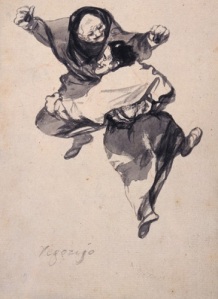
Fancisco Goya, ‘Women jumping’, from his ‘Witches and old women’ album, late 18th to early 19th century.
OK, so most of us recognise that the demographic is changing: that the older generation is beginning to overtake the younger by a considerable margin. But that’s ‘recognise’ in theory. Certainly in the media, advertising and the arts, the consciousness lag, the large-scale head-burying in the sand is unjust and majorly irritating. Meanwhile in literature and art the caricaturing, stereotyping, pigeonholing and sidelining of older people persists.
An article in the New York Times on 26 January 2014, and the piece it provoked the next day in The Huffington Post by novelist Holly Robinson, bear me out. The original text, Writer of a Certain Age, reported novelist Fay Weldon’s advice to her creative writing students to avoid the ‘mistake’ of writing a book with a main character in her 50s: ‘mistake’ because agents and publishers probably wouldn’t touch it. Holly Robinson’s agent agreed emphatically when Robinson proposed a novel with a main female character approaching her 60s. But this isn’t just about the negative views towards older age of agents and publishers: although more women buy books than men, most purchasers are younger than 45. The audience too, you see. (http://www.huffingtonpost.com/holly-robinson/how-old-is-too-old-for-a_b_4676796.html). The problem doesn’t just stem from the wilful blindness of a few professions but of society at large.
As an older woman I’ve combed modern fiction, poetry, paintings and more for a sensitive and nuanced attention to my stage and state of life. And the good news is that slowly, slowly, the situation is changing. Here, f’rinstance, are a few recent examples of novels with a rounded, authentic, older female protagonist:
– Hilary Boyd: Thursdays in the Park; Tangled Lives; When You Walked Back into My Life;Solstice, co-written with Barbara Roddam (Boyd specialises in the possibility of romantic relationships for older women, but – sadly, in my view – has got labelled with the ugly term ‘grannylit’).
– Sheila Hancock, Miss Carter’s War (inspired by seeing an older woman in a shop being ignored).
– Stewart O’Nan, Emily, Alone.
– Elizabeth Strout, Olive Kitteridge.
– There’s also my own attempt of course: On the Far Side, There’s a Boy (http://www.amazon.com/On-Far-Side-Theres-Boy/dp/178279574X).
In 2010, just before Mothers’ Day, Carol Ann Duffy commissioned poets to write with sensitivity about age and ageing. The results are wonderful, for instance Gillian Clarke’s poem Blue Hydrangeas, September:
‘You found them, lovely, silky, dangerous,
their lapis lazulis, their indigoes
tide-marked and freckled with the rose
of death, beautiful in decline.
I touch my mother’s skin. Touch mine.’
Other poems are Old Flame by Linda Chase; What I Regret by Nina Cassian; Mrs Baldwin by Fleur Adcock; Ageing by Ruth Fainlight; and many more. You can even hear some being read if you follow this link: http://www.theguardian.com/books/2010/mar/13/carol-ann-duffy-poems-ageing.
Then there are a burgeoning number of films in a trend towards foregrounding older characters that arguably started with Mama Mia: The Best Exotic Marigold Hotel, Quartet, The Second Best Exotic Marigold Hotel… (though these border on cliché here and there, not to mention the obligatory comedy and happy ending).
So how do we get more of all this? By commenting on and reviewing such literature etc. enthusiastically when it comes out, obvs. And with the internet, there’s the scope for mass evangelising. Some of this can come from older writers and artists, can’t it, since they know whereof they speak? Hence it’s great to see the website Bloom,
‘a literary site devoted to highlighting, profiling, reviewing and interviewing authors whose first major work was published when they were age 40 or older. Bloom is also a community of artists and readers who believe that “late” is a relative term, not an absolute one, and who are interested in bringing to attention a wide variety of artistic paths – challenging any narrow, prevailing ideas about the pacing and timing of creative fruition. If someone is labeled a “late bloomer”, the question Bloom poses is, “Late” according to whom?’ (http://bloom-site.com/about/)
Note that Bloom is for readers as well as creators, so even if we’re not arty, we should use it, and support it to the hilt. (Not that older creative types should feel some sense of obligation, or constriction, to focus on their own generation – any more than younger types should stick to a youthful agenda. Think Mary Wesley, who began writing adult fiction at the age of 71, but whose palette was broad and deep.)
Internet articles are more and more celebrating older women artists and their work. Age shall not wither her by Emine Saner in 2008 spotlights Paula Rego, Gillian Ayres, Ana Maria Pacheco Maria Lassnig, then 89 (who, like me, never married or had children) and Natalie d’Arbeloff. d’Arbeloff, guest editor of the piece, argues that
’emotional involvement in itself undeniably soaks up art-making energy for many female artists, and can divert it….I wanted to know how those who are the exception managed to focus their creative elan consistently and continuously throughout a long career’ [my italics]
– which is what the feature examines (http://www.theguardian.com/lifeandstyle/2008/jun/18/women.healthandwellbeing).
Jackie Wullschlager’s In praise of older women (2010) claims that
‘now old age among female artists and writers is the new chic….In the 21st century, creative women in their eighties and nineties such as Louise Bourgeois…, Leonora Carrington… and Diana Athill… emerged from the tunnel of obscure middle-age to become glamorous if not household, at least drawing-room names.’
She also cites Bridget Riley (now 84); recently deceased Agnes Martin, Joan Mitchell and Alice Neel; and Yayoi Kisama, in her eighties and living in a Tokyo mental hospital. This is an insightful piece, highlighting how the fact that the ‘male-dominated highways’ of the art world are still catching up with feminist thought at all is one reason for the marginalisation of younger, as well as older, female artists – hence the older ones’ ‘late blooming’. I love Wullschlager’s description of one of Lassnig’s artworks, a naked and frank self-portrait aged 86
‘holding two guns, one pointing at her head, the other at the viewer – the uncompromising stare challenging us to underestimate the emotional life of old age’.
Wullschlager asks:
Will these be the grandes dames of mid-21st century art? The belated triumphs of Bourgeois, Rego and Kusama show that the tortoise is as likely to win as the hare.’
It would be great if she were right.
Lest we become sexist about this, male creatives can be enlightened and nuanced about older women, too. One of the best on the subject of Us (IMHO) dates back a while. The fantastic exhibition of Francisco Goya’s album, these days titled The Witches and Old Women, is on at the Courtauld Gallery, London until 25 May this year. Goya doesn’t just move beyond the stereotypes (witch, hag, harridan, sex-starved madwoman, old maid, harpie, repulsive crone, spiteful bitch, obscene lustress, overdue corpse): he treats and overturns them. A classic example of this is Until death.
At first glance, a decaying, over-prettified woman seems to be preening herself in her finery before a looking glass, rightly whispered about by the sneering dandies in the background. But look again and there’s something kinder and more generous than this about it: Goya seems to understand her need to enhance her looks, empathises with her desire to maintain appearances. And the onlookers – apart from the sympathetic or thoughtful maid – seem, well, a bit nasty themselves. The sketch is multi-layered: it’s also about the indomitable spirit of old age.
In this album and others, there are cartoons (in the original sense of the word) of two old women pulling each other by the hair and tumbling together as if into an abyss (They descend quarrelling); but equally, of a merrymaking older couple, man and woman, laughing and rising up in blank space, as if on an updraught of happiness (They ascend joyfully). Old age brings rages, Goya seems to tell us – and, perhaps more unexpectedly, energy and strength; but joy and pleasure too.
There are also sweet, touching, dare I say almost inspirational, images: the devotion and stoicism of an old woman totally absorbed and hunched in prayer in She won’t get up till she’s finished her prayers; Content with her lot, a toothless old woman dancing playfully on her own shadow to the accompaniment of castanets – yes, old age can bring fun, even ecstacy; and an almost algebraic equation of equalised power with Expressive of double strength, a sketch of an old woman struggling forcefully with a man on the ground. Then there are the ones at the top of this piece, of course: the first, a tender portrait of an old lady examining herself in the mirror, quite untroubled by her ancient looks – a neat, more reassuring companion to Until death.
Goya excels at titles. I’m tempted to see him almost as the earliest blogger in the way that he combines his words with images. There’s Old women fight too. I especially like his Just can’t go on at the age of 98, a depiction of an ancient (man or woman, it’s hard to say), bowed over and hobbling along painfully on two sticks. The point is that s/he IS going on, and will. Funniest title-image coupling is perhaps Showing off? Remember your age, in which an old man is careering helplessly and headfirst down the stairs. Goya reminds us here, figuratively as well as metaphorically, that we’ll all, both women and men, be levelled to a new plane by old age.
If Goya could do it in the 1790s, there must be more bloggers, writers, artists of all kinds who can dissect oncoming age in witty, wonderful and sensitive, nuanced ways – and people who will encourage them and champion them when they do.
The theme of 2015’s International Women’s Day on 8 March was ‘Empowering Women, Empowering Humanity: Picture It!’
Now although I’m not religious, I don’t have anything against anyone who is, just so long as they try to do good with it, not harm (which is rather what I thought religion was for, after all). And I’m emphatically pro female empowerment, ergo female leaders; at least, female ‘leaders’ in their own way (see my recent post ‘Women leaders: PC puzzles, if women “lead from behind”, how can we be seen?’: https://boywoman.wordpress.com/2015/02/01/women-leaders-pc-puzzles-if-women-lead-from-behind-how-can-we-be-seen/).
Recently Libby Lane became the Church of England’s first female bishop (http://www.bbc.co.uk/news/uk-30514956). In the midst of the celebrations there was an outburst from some old fogey in the congregation; and still, only some 20 or so Anglican women bishops do their work around the world. Why the slow progress, the opposition? Some say that women can’t even be priests: that for them, even priesthood seems an ‘authority’ that Scripture doesn’t reflect. As for bishops, the reactionary camp believes that it’s theologically impossible for women bishops to ordain priests, and that in any case Scripture requires male headship in the Church; more, that women’s ordination puts a brake on any hopes of unity with Roman Catholics.
But, surprise surprise (not), the non-canonical Christian texts, apocryphal or gnostic gospels, so-called, i.e. the ones rejected by the male-dominated ancient Church, give women greater prominence. In one narrative, actually titled the Gospel of Mary (Magdalene), Christ says,
‘Mary Magdalene and John… will tower over all my disciples and over all men who shall receive the mysteries in the Ineffable. And they will be on my right and on my left. And I am they, and they are I.’
In another, Christ asks his mother Mary, Martha, Salome and Mary Magdalene to answer his questions about scripture; when Peter objects to the female participation, Jesus corrects him and urges Martha to continue. In the so-called ‘First Apocalypse of James’, James asks,’Who are the seven women who have been your disciples?’; Jesus reveals four to be ‘Salome and Mariam and Martha and Arsinoe’.
Mary Magdalene was actually titled ‘Apostle to the Apostles’ by Hippolytus, bishop of Rome c. 170-235, according to Thimmes.
Even within the Biblical canon, female disciples feature widely, as in this account in James of Christ’s wide-roaming ministry:
‘And the twelve were with Him, and also some women who had been healed of evil spirits and infirmities: Mary, called Magdalene, from whom seven demons had gone out, and Joanna, the wife of Chuza, Herod’s steward, and Susanna, and many others, who provided for them out of their means.’
In my last post I argued that history, the long tradition, across a whole gamut of cultures, of female high priesthood, was too pervasive to be ignored. The female presence in the non-canonical scriptures – texts sidelined by a largely patriarchal Church – often is.
But if Christianity is trying to repress us even in present times, in other religions today we women won’t so easily be kept down. In the Americas, the religious tradition of Santeria (a derogatory term suggesting ‘deviancy’ from Roman Catholicism), originated in the Caribbean, and recognises priests and priestesses equally. Some of its rituals revolve around three thrones that represent respectively the seats of the religion’s kings, warrior gods and (my italics) queens.
On 4 March 2007, a humble 21-year-old village girl was ordained as the only, not to mention youngest, female High Priestess of Hindu Dharma, the traditional belief system on the island of Bali. This, because despite a previous total lack of interest in things spiritual she suddenly began to have out-of-body and near-death experiences, claimed to have received divine instruction, and was able to speak the mantras in Sanskrit and other ancient languages, perform the sacred hand movements known as mudras and to undertake other sophisticated religious rites – almost overnight.
In the neo-pagan religion of Wicca, there’s a long legacy of female oracles, enchantresses and prophets, led by a high priestess. Some Wiccan high priestesses initiate secondary high priestesses for regional covens; the iconography occasionally illustrates them with symbols or artefacts specifically representing, separately, male and female energy. However, in a move towards democracy, many covens today reject the concept of one high priestess in favour of seeing each woman member as the priestess of her own religious development.
A 2010 online piece reported that in Pune, India, more than 20 women from all Hindu castes were currently enrolled in a one-year priesthood course, most of them ‘housewives’, aged 40-65.(Needless to say, many Indian men have strongly resisted this move.) (http://www.dw.de/female-hindu-priests-in-india-are-making-strides-in-a-male-dominated-profession/a-5569382)
Perhaps most surprising and heartening of all given the extremist/conservative religious stereotypes of Islam currently prevailing in much western culture, in Los Angeles M. Hasna Maznavi, a Muslim woman, recently started the first all-female mosque as part of a
‘modest, multi-faith center, where Muslim women and women of other faiths joined together for a Jumu’ah, a congregational prayer Muslims hold every Friday, and a Khutbah, a public sermon….
‘And unlike most U.S. mosques that have a male imam, or leader, a woman led the traditional prayer and gave the sermon.’ (http://abcnews.go.com/US/1st-female-mosque-opens-us/story?id=28725435)
How shaming if Christianity were to lag behind all these other religious strands.
Online and off, claims are multiplying that the 21st century should and/or will be the Female Century: see for instance UN Women Executive Director Michelle Bachelet’s address in 2011 at the Lincoln Center, New York (http://www.unwomen.org/en/news/stories/2011/9/the-21st-century-will-be-the-century-of-girls-and-women), and men too: Tom Brokaw in Lean In in 2013 (http://leanin.org/discussions/welcome-to-the-century-of-women/).
As far as female religious leaders go, it would be good to agree with them that a new feminine era is, or should be, almost here. I can’t do better than quote Priestesses, Power, and Politics again:
‘All over the world women are mounting powerful challenges to masculine domination of religious institutions. Catholic and Hindu and Buddhist women are campaigning for full female ordination in their traditions. Muslim feminists are asserting their right to interpret the Quran and hadiths. The daughters of Sarah are demanding to be counted as Jews (literally) in the minyan and rabbinate, and for women’s right to lead services at the Western Wall of the ancient temple of Jerusalem….
‘The burgeoning pagan and feminist spirituality movements are laying new foundations of Goddess veneration and female spiritual leadership. American Indian women are reclaiming the right to sit at the powwow drum, and sistahs of the African diaspora have retaken the conga and djembe for their own. Lucumi priestesses are reinvigorating female power in the orisa traditions of west Africa, and breaking down gender barriers to initiation as prestigious diviners….’ (http://www.suppressedhistories.net/articles/priestesses.html)
Wouldn’t it be great – not to mention interesting – if the time for female leadership, religious and otherwise, really was almost here?




